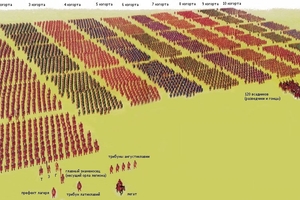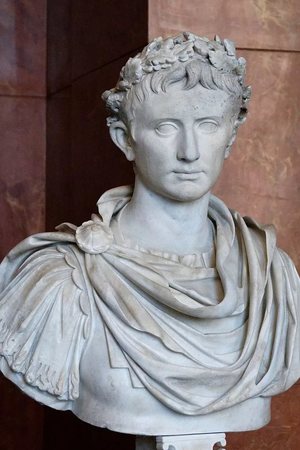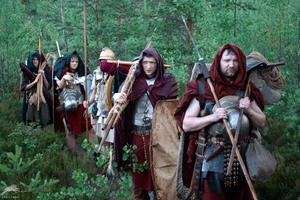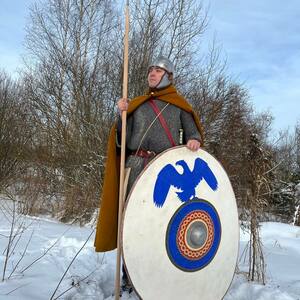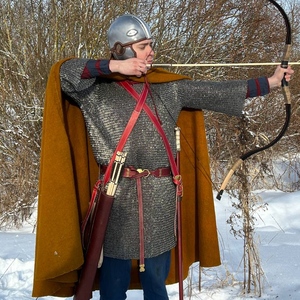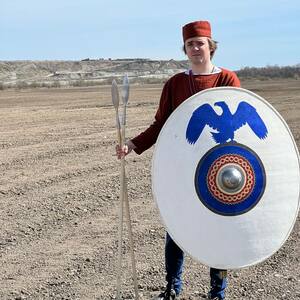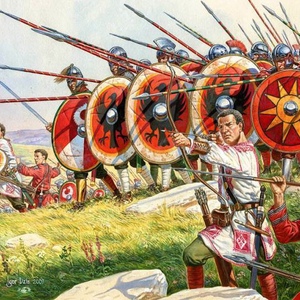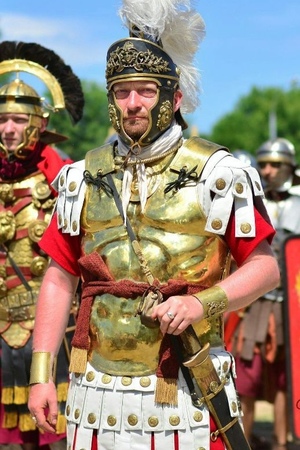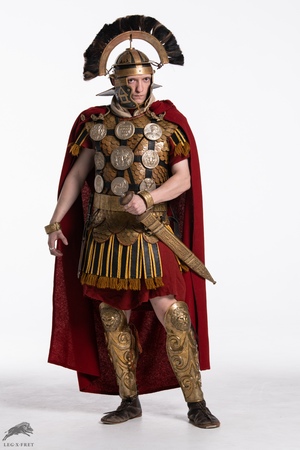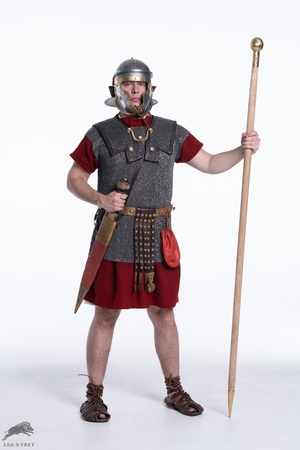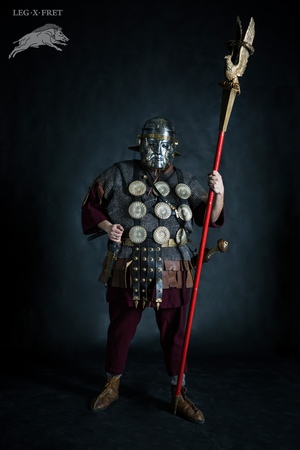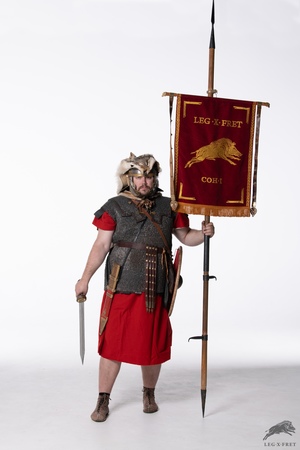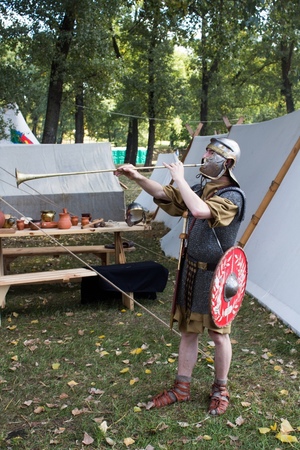Legion
A legion (Latin: legio) is the main military unit of the Ancient Roman army, which had its own unique structure. Powerful and tireless, it was the legions that became the driving force that allowed Rome to establish its hegemony over the territory of most modern European countries and in the East, and it was the legionnaires who built the greatness of Roman civilization on their shoulders.
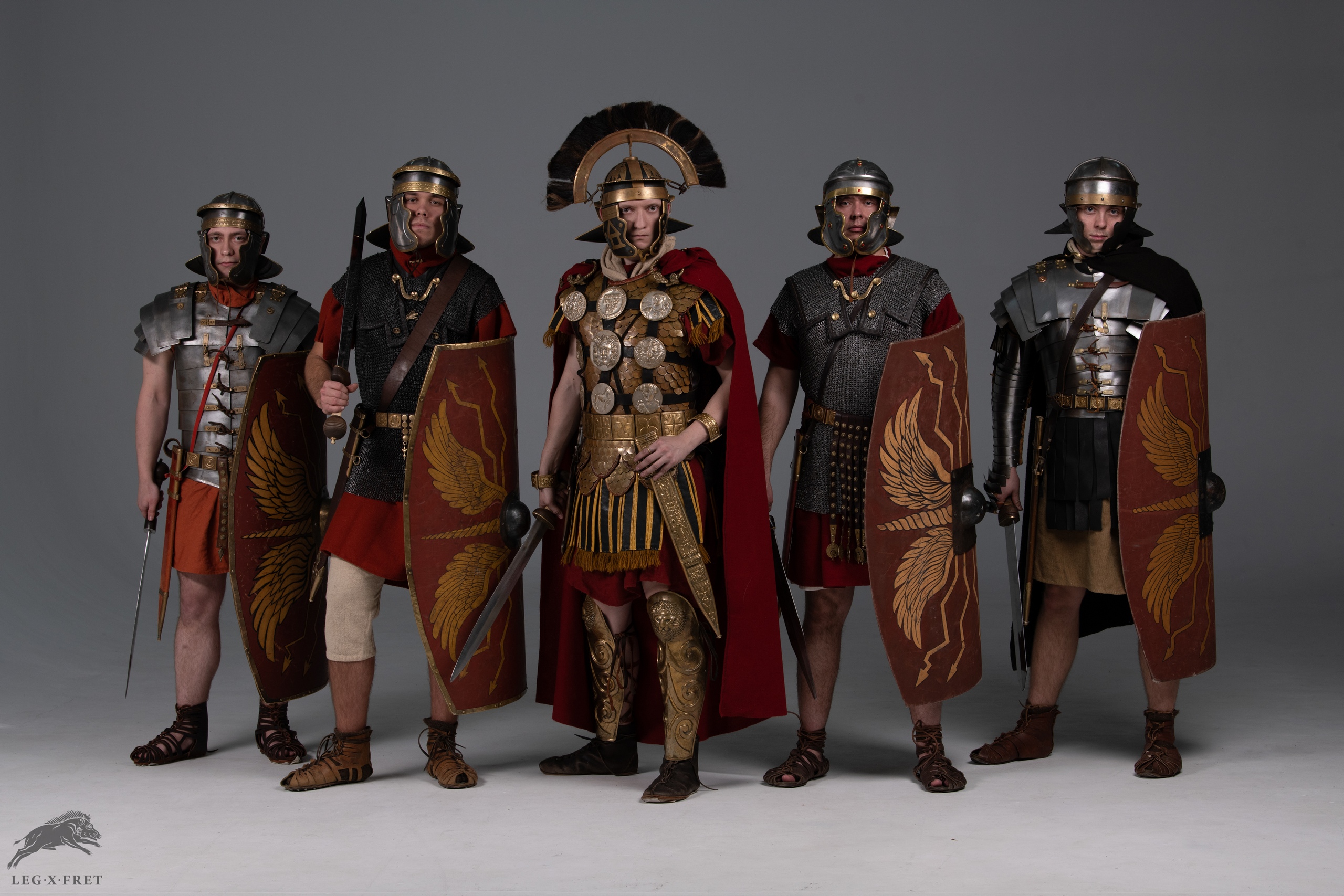 Legionnaires of Legio X Fretensis. Reconstruction
Legionnaires of Legio X Fretensis. Reconstruction
Historical path of the legions
Army of Royal Rome
From a certain point of view, it can be argued that legions existed from the very dawn of the Roman state. In the era of Royal Rome, an irregular militia of 3,000 infantrymen and a small number of horsemen were called a legion - from the Latin lego - to collect. At that time, the formation of the militia was based on a tribal basis, each of the 33 Roman curiae put forward 100 infantrymen and 10 horsemen, which, presumably, allows us to calculate the exact number of infantrymen as 3300 and horsemen - 330. It is not known for certain whether there were any battle orders before the 6th century BC, which could be used by the Romans in battles, the first known organizational reforms were carried out by the semi-legendary Roman king Servius Tullius (578 - 535 BC).
Reforms of Servius Tullius
According to the Servian Constitution introduced by Tullius, such reforms as universal military duty, including for plebeians, to whom the Constitution granted citizenship, the introduction of higher military command - two military tribunes, property census, and age division of the population when recruiting into the army: the division was made into juniors - male citizens from 18 to 46 years old, and seniors - citizens older than 46 years. Juniors could form the basis of the army in campaigns and battles, while seniors were intended to serve in the garrison and reserves. At the same time, centuries are mentioned for the first time, and the main battle order is the phalanx.
The property census in this case implied the imposition on citizens of the obligation to put forward equipped centuries for service in the legion. Thus, all citizens were divided into 6 classes, the first of which were the richest citizens, and who were obliged to put forward 80 centuries, in which each warrior was equipped with a bronze helmet, cuirass, shield, and sword, daggers. Warriors of this class formed the basis of the army - the front. Representatives of the lower classes put forward fewer centuries, the warriors in which were equipped weaker, for example, warriors of the fourth class carried spears and darts into battle, warriors of the fifth - only slings and stones. It should be noted that the centuries of different classes also differed in size, without having a clearly prescribed organizational structure.
Legions of the Early Republic
The next step in the development of the legions took place in the period of the early Republic - the legion, still being a single army, was divided into two separate units, each of which was subordinated to one of the consuls. Legionnaires were assigned a small salary. Later, due to the increasing number of wars in which the young Republic was entering, the total number of legions was increased to 4, two for each consul.
Approximately from the middle of the 4th century BC, a military tribune was appointed at the head of each legion. At the same time, there is a transition from phalanx tactics to maniples, possibly borrowed from the Samnites during the Samnite Wars. At this time, the legion begins to count approximately 5,000 warriors, divided into 30 maniples, which in turn each consisted of two centuries of 80 - 100 legionnaires. Each century was managed by a centurion. The legion's cavalry still counts 300 horsemen, equites, divided into 10 turmae of 30 people each. At this time, units of allied forces assigned to legions are mentioned for the first time - alae auxiliarium, units recruited from non-citizens, who joined the auxilia for earnings and the opportunity to obtain citizenship at the end of their service.
The type and equipment of the warriors themselves also change - instead of hoplites, new classes of Roman infantry appear - principes, hastati, and heavy triarii, light infantry velites. Greek-style equipment and armor are also being replaced - instead of the hoplon, the main shield for some warriors becomes the scutum, the mass use of pilums begins.
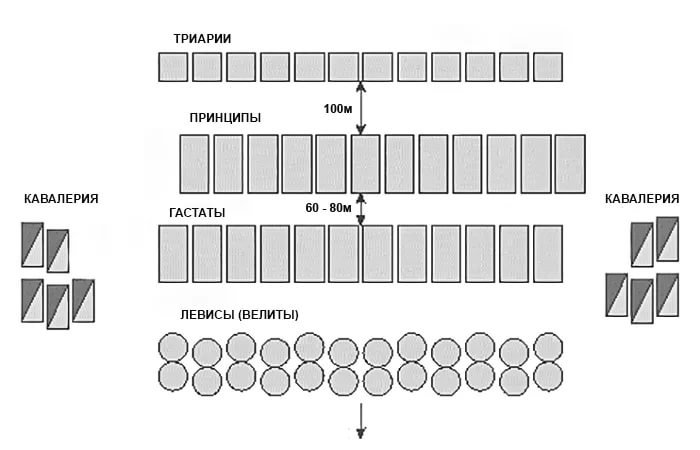 Order of battle of the legions of the early Republic
Order of battle of the legions of the early Republic
A new battle order is introduced - maniples are built in a checkerboard order in three lines, in the first of which hastati were placed, the youngest warriors, then principes, warriors who already had some combat experience, and in the last line - triarii, who were elite warriors - veterans, and entered the battle only in case of an extremely desperate situation in the battle, under the threat of defeat. The winged Latin expression "Res ad triarios rediit" - "It has come to the triarii.", meaning a desperate situation requiring decisive action, has survived to this day. Velites were usually placed in front of the hastati, who were supposed to pelt the approaching enemy line with pilums and retreat. Equites, divided into two squads of 150 people each, were placed on the flanks.
With such an organization, the Roman legions participated in the first and second Punic Wars (264 - 201 BC). In the Third Punic War (149 - 146 BC), a new tactic was introduced into the legions - the tactic of cohorts.
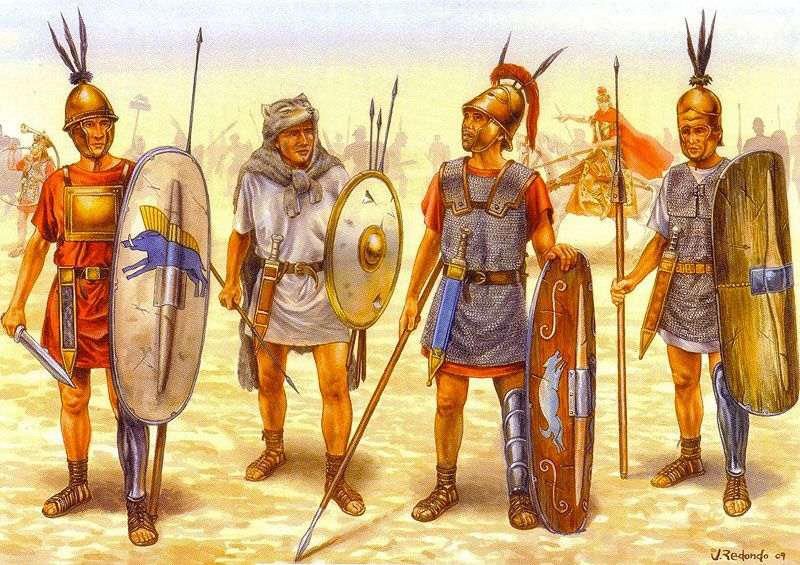 Legionnaires of the early Republic - Hastatus, Velitus, Triarius, princip
Legionnaires of the early Republic - Hastatus, Velitus, Triarius, princip
Legions of the Late Republic
From the end of the 2nd century BC, as a result of the reforms of the military leader Gaius Marius (158 - 86 BC), legions began to be divided into cohorts. A legate was placed at the head of the legion, under his direct subordination were six tribunes. Initially, one cohort included two maniples and about 400 legionnaires, then during the development the division simplified to 6 centuries within one cohort, and to about 480 legionnaires. The exact numerical composition of the legion units is difficult to determine with high accuracy, as it often changed with various reforms, and depended on the ability to replenish the legion with new recruits. It is known that the number of legionnaires could vary from 4800 to 6000. The tactic of three checkerboard lines is gradually replaced by continuous construction in several lines, there is a gradual unification of equipment, weapons and armor of legionnaires. The division into hastati-principes-triarii ceases, the least experienced legionnaires are placed in the sixth century of the tenth cohort, while the most experienced make up the first century of the first cohort, under the command of the primipilus (senior centurion).
At the same time, universal military conscription is abolished, the legions become a professional army. Only citizens who have expressed their own desire are admitted to the ranks of the legionnaires. The appearance becomes more unified - all legions have more or less similar uniforms and equipment, with minor differences. This was associated with the transition from independent purchase of equipment by legionnaires to centralized state supply. Legionnaires begin to wear hamata, the scutum finally becomes the main shield, now absolutely all legionnaires wear pilum.
Legionnaires of the Principate Period
The time of upheaval, which was the period of the end of the Republic, affected the legions as well. Their total number increased to about 70, many of them, located on the borders, were more loyal to their commanders than to the central authority emanating from Rome.
Emperor Octavian Augustus (63 BC - 14 AD) sought to change this situation - he reduced the number of legions to 25, while increasing their numerical strength to approximately 7000. All legions were given numbers and names, usually according to the place and order of their formation, or for military merits. Subsequently, the equipment of the legionnaires was significantly modernized, the appearance of the lorica segmentata, the shape of the scutum changed slightly.
In general, not taking into account some changes in the administrative and command staff, in this form the legions existed until the beginning of the 3rd century AD. This period can safely be called the "golden age" of both the Roman Empire, which reached its greatest power and peak of its territorial size, and the legions themselves, which were practically invincible at this time, and the most advanced combat units in the world both in terms of their weapons and armor, and in terms of training and logistics. On campaigns, legions could cover huge distances in a relatively short time for infantry, thanks to paved roads, which were built by legionnaires in peacetime. The castra, built by the legions, guarded the borders of the Empire, and sometimes contributed to the growth of entire cities.
Late Roman Legions
A series of crop failures, epidemics, external and civil wars, known as the Crisis of the Third Century, led to serious changes in all aspects of life in the Roman state, and not least - in the armed forces. More about the reasons for this can be read in the relevant article, below will briefly describe the equipment, organization and tactics of the Roman legions of the Dominate era.
By the beginning of the 4th century AD, the equipment and armament of the legions had changed significantly. Helmets acquired a simpler design, clearly imitating Persian, lorica segmentata fell out of use, replaced by a long-sleeved and long-skirted chainmail or scale armor. The scutum was replaced by a round or oval shield of a lenticular profile. The main close combat weapon became the hasta, the gladius was replaced by the spatha. According to Vegetius, the fighters of the first ranks also wore greaves. Legionnaires could still use pilums (of a somewhat simplified design, in some sources they received the name spiculum), lighter darts-lanceae, or plumbatae - small darts, weighted with lead.
By the 4th century AD, the legions began to number about 1000-1200 infantrymen, including heavy infantry, archers, and slingers. Cavalry and artillery were singled out into separate army units and were given to the legions as needed.
The significantly increased number and combat effectiveness of the cavalry in the 3rd century allowed it to take on a large part of the maneuvers on the battlefield, requiring initiative and mobility. Roman infantry now served as the basis of the army's battle formation and led predominantly defensive battles. Legionnaires rained down a hail of arrows and darts on the attacking enemy, and then took his blow on the wall of shields and spears.
The tactics, organization, and equipment described above fully met the demands of their time, as evidenced by the numerous victorious wars of Rome in the second half of the 3rd and almost all of the 4th centuries. By the middle of the 5th century, however, the economic decline of Western Rome deprived its army of the physical ability to realize its military potential and ultimately led to the collapse of the state. Eastern Rome, on the other hand, preserved and multiplied the legacy of the legions until the thematic reform of the 6th century AD.
Legion Officer Corps
At different times, the officer corps could undergo changes, however, to understand the general structure of the legion's management, one can look at the officers of the 1st-2nd centuries AD.
Senior Officer Corps
At the head of the legion was the Legate. This position could denote both a military tribune, who directly commanded the legion, and a governor of a province, who managed the territory where his legion was located (legate propraetor). Under the command of the legate were five military tribunes from the equestrian order, and one tribune laticlavius - a young senator, appointed to the position by the senate or the emperor. Despite less experience in the military craft, the tribune laticlavius was second in seniority after the legate. In addition to the tribunes, the prefects - veterans who received this position after serving as centurions - were also considered senior officers.
Middle Officer Corps
1) Primipil (primus pilus) - senior centurion, who headed the first double century of the first cohort. Like a centurion, the primipil led the legionnaires into battle, being with them in the same formation. After dismissal, primpilus were granted the status of a knight and the opportunity to enter civil service.
2) Centurion - the commander of the century, an officer who lived the daily life of his subordinates, and directly led them on the battlefield. Centurions were elected from veteran soldiers, but there could be exceptions. In total, there were 58 centurions in the legion, according to the number of centuries, and one centurion primipilus.
Junior Officer Corps
1) Optio - the right hand of the centurion, the optio could replace a wounded or killed commander in battle. He was chosen by the centurion from among the legionnaires of the century.
2) Tesserarius - assistant to the optio, mainly involved in organizing the security of the castrum during stops.
3) Decanus - commander of 8 or 10 soldiers, who made up a contubernium, lived in one tent with his subordinates.
4) Decurion - commander of a turma - a detachment of legionary cavalry of 30 horsemen.
Special Legion Staff
1) Aquilifer - the one who carries the eagle. A very important position, for which an experienced legionnaire was elected. The task of the aquilifer was to protect the legionary eagle at all costs, as the loss of the eagle was equivalent to the loss of the legion's genius, and was considered a terrible disgrace, leading to the disbandment of the legion. For his service, the aquilifer received generous payment.
2) Vexillarius - the one who carries the standard. He carried the vexillum - the standard with the name and symbol of the legion.
3) Signifer - the one who carries the signum. Signifers were at every unit from the century and above. The signum was a pole, decorated with phalerae - the military awards of the unit, thus telling about its combat path. At the top of the pole was a palm - a symbol of the oath of loyalty sworn by the legionnaires. For special merits, the palm could be framed with a laurel wreath. Moreover, the signifer could act as a treasurer.
4) Bucinator - a trumpeter, who played on a coiled copper trumpet - the buccina. They were with the standard-bearer, transmitting orders by horn signal.
5) Tubicen - a trumpeter, who played on the tuba - a stretched straight bronze tube. He was with the legate, transmitting the signal to advance or retreat.
Similar Topics
Auxiliary, Century, Cohort, Castrum, Legionnaire, Legion's Standard Group, Roman Army, Royal Rome, Soldiers of the Roman Empire of the Dominate era, Dominate

 Gallery
Gallery






Literature
- Polybius. Universal History.
- Titus Livy. History of Rome.
- Scriptores Historiae Augustae. - (Trans. S. N. Kondratyev)
- Silvano Mattesini. Roman Legions. All about the most powerful army of the Ancient World / Trans. from Italian by I. E. Andronov. - M.: Astrel, 2012. - 216 p.
- Makhlayuk A. V., Negin A. E. Roman Legions. The most complete illustrated encyclopedia. - M.: Eksmo, 2018. - 416 p.
- Henry Michael Parker. History of the Roman Legions. From the military reform of Gaius Marius to the ascension of Septimius Severus / Trans. from English by L. A. Igorevsky. - M.: ZAO "Centrpoligraf", 2017. - 224 p.
- The Roman Army in the 4th Century. From Constantine to Theodosius. A.V. Bannikov
- Armies of the Late Roman Empire. AD 284 to 476. History, Organization and Equipment. G. Esposito
- Rerum Gestarum, Ammianus Marcellinus
